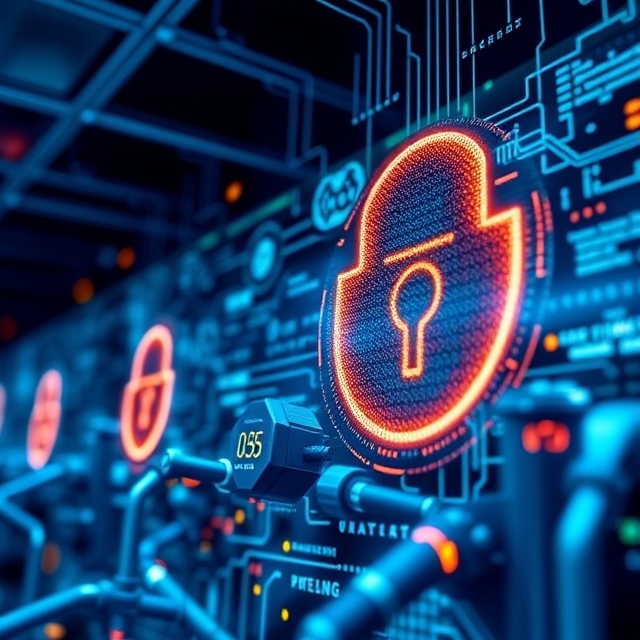In today’s digital world, cybersecurity plays a critical role in keeping our personal and business information safe.
As technology grows, so do the risks of cyberattacks, making cybersecurity more important than ever.
What is Cybersecurity?
Cybersecurity is the practice of protecting devices, systems, networks, and data from cyber threats like hacking, viruses, and scams. It involves using tools and strategies to stop unauthorized access, theft, or damage to information. This can include strong passwords, antivirus software, and secure networks.
Why is Cybersecurity Important in 2025?
In 2025, as people rely more on the internet for work, shopping, banking, and socializing, the risks of cyberattacks are increasing. Here’s why cybersecurity is essential:
- Protection of Personal Data: Hackers target sensitive information like credit card details, passwords, and personal files. Cybersecurity helps keep this data safe.
- Business Security: Companies store huge amounts of data online. Cybersecurity prevents cyberattacks that can lead to financial losses or damage a company’s reputation.
- Critical Infrastructure: Many important systems, like energy grids and hospitals, rely on technology. Cybersecurity ensures these systems keep running without disruptions.
- Fight Against Cybercrime: As cybercriminals become more advanced, strong cybersecurity measures are needed to prevent fraud, identity theft, and data breaches.
Cybersecurity is a shield that protects individuals and organizations from the growing dangers of the digital age, making it a must-have for everyone.
A Brief History of Cybersecurity
Cybersecurity has come a long way from its early beginnings, evolving with the growth of technology and the internet. Here’s a look at how it started, key moments in its development, and the major attacks that shaped today’s security practices.
The Early Days: Protecting Basic Systems
In the 1970s and 1980s, computers were used mostly in research and government projects. Cybersecurity in those days focused on basic protection:
- First viruses: The Creeper virus (1971) was one of the earliest computer threats, spreading between systems. This led to the creation of the first antivirus program, Reaper.
- Passwords and firewalls: Early systems relied on simple passwords and basic firewalls to block unauthorized access.
As the internet grew in the 1990s, so did the risks. Hackers began targeting personal computers and networks, which pushed cybersecurity to develop further.
Major Milestones in Cybersecurity Development
- 1990s: Rise of Antivirus Software
Companies like Norton and McAfee developed tools to detect and remove malware, becoming essential for computer users. - 2000s: Firewalls and Encryption
As cyber threats increased, firewalls became standard for protecting networks, while encryption secured data in transit. - 2010s: Cloud and Mobile Security
With the rise of smartphones and cloud computing, cybersecurity expanded to protect devices, apps, and online data storage. - Artificial Intelligence in Security (2020s)
AI and machine learning became tools for detecting and stopping cyber threats more quickly and efficiently.
Cyber Attacks That Shaped Modern Security
- Morris Worm (1988)
This early worm caused massive disruptions, spreading across networks and highlighting the need for better system protection. - Target Data Breach (2013)
Hackers stole millions of credit card details, prompting businesses to improve data security and customer protection. - WannaCry Ransomware (2017)
This global attack encrypted users’ files, demanding payment to unlock them. It showed the dangers of ransomware and weak system updates. - SolarWinds Attack (2020)
Hackers infiltrated government and corporate systems through a software vulnerability, emphasizing the need for stronger supply chain security.
Cybersecurity has grown into a complex and vital field, shaped by the challenges and lessons of the past. Today, it continues to adapt to the ever-changing digital landscape.
How Cybersecurity Works
Cybersecurity is all about protecting computers, networks, and data from threats. It uses tools, technologies, and strategies to stop attacks and keep information safe. Here’s how it works and the key elements involved.
Key Tools and Technologies Used in Cybersecurity
- Firewalls
Firewalls act as barriers between trusted networks and potential threats from the internet. They monitor and control incoming and outgoing traffic, blocking anything suspicious. - Encryption
Encryption protects sensitive data by converting it into a coded format that only authorized users can read. This ensures that even if data is intercepted, it cannot be misused. - Anti-Malware Software
These programs detect and remove harmful software like viruses, spyware, and ransomware. They are constantly updated to handle new threats. - Intrusion Detection and Prevention Systems (IDPS)
These tools monitor network traffic for unusual activity and take action to block potential threats in real time. - Two-Factor Authentication (2FA)
This adds an extra layer of security by requiring a second verification step, like a code sent to a phone, alongside a password.
Understanding Firewalls, Encryption, and Anti-Malware
- Firewalls: Think of them as gatekeepers for your network. They decide what data can enter or leave based on set rules.
- Encryption: It’s like locking your data in a safe. Only those with the right key can unlock it and read the information.
- Anti-Malware: These are your system’s immune system, fighting off harmful programs that try to infect your devices.
The Role of Ethical Hackers in Securing Systems
Ethical hackers, also known as “white hat hackers,” play a vital role in cybersecurity:
- They simulate cyberattacks to find vulnerabilities in systems before real hackers exploit them.
- They help organizations improve their defenses by identifying weak spots and suggesting fixes.
- Ethical hackers work with companies to test firewalls, encryption, and other security measures, ensuring everything is secure.
Cybersecurity is a combination of technology, tools, and skilled professionals working together to stop threats. By using advanced techniques and staying one step ahead of hackers, it helps protect our digital world.
The Current Landscape of Cybersecurity
As the digital world grows, so do the risks. Cybersecurity in 2025 is a constantly evolving field, with businesses and individuals facing new and sophisticated threats. Here’s an overview of the key challenges and how companies are fighting back.
Top Cyber Threats Facing Businesses and Individuals Today
- Ransomware Attacks
Cybercriminals use ransomware to lock users out of their systems or data, demanding payment to restore access. These attacks target businesses, hospitals, and even schools. - Phishing Scams
Phishing remains a major threat, where attackers trick people into sharing sensitive information like passwords or credit card details through fake emails or websites. - Data Breaches
Hackers target businesses to steal sensitive customer or company data, which can then be sold on the dark web. - IoT Vulnerabilities
Internet of Things (IoT) devices like smart home gadgets are often poorly secured, making them easy targets for attackers. - Advanced Persistent Threats (APTs)
These are prolonged and targeted cyberattacks on businesses or governments, often aimed at stealing valuable data or disrupting operations.
Recent Cyber Attacks and Their Impact
- Colonial Pipeline Attack (2021)
A ransomware attack caused fuel shortages across the U.S., highlighting the vulnerability of critical infrastructure. - T-Mobile Data Breach (2023)
Millions of customer records were exposed, causing financial and reputational damage. - Log4j Vulnerability Exploit (2024)
This software flaw allowed attackers to gain control of systems globally, affecting businesses and governments.
These incidents show how damaging cyberattacks can be, from financial losses to disruptions in essential services.
How Companies Are Responding to New Threats
- Stronger Security Measures
Businesses are investing in advanced firewalls, encryption, and multi-factor authentication to protect their systems. - Employee Training
Many companies are educating employees about phishing and other scams, as human error is often the weakest link in cybersecurity. - Zero Trust Approach
Companies are adopting a “trust no one” strategy, where every user and device must be verified before accessing data or systems. - Partnerships with Ethical Hackers
Organizations are hiring ethical hackers to test their systems for vulnerabilities and improve their defenses. - Incident Response Plans
Businesses are preparing detailed plans to quickly respond to cyberattacks, minimizing damage and restoring operations.
Cybersecurity today is about staying ahead of the attackers. By understanding the risks and adopting proactive strategies, individuals and businesses can better protect themselves in an increasingly connected world.
The Future of Cybersecurity
The future of cybersecurity is shaped by advanced technologies and new strategies to tackle evolving threats. As cybercriminals become more sophisticated, the tools and methods to combat them must also improve. Here’s what lies ahead.
Emerging Technologies in Cybersecurity
- Artificial Intelligence (AI)
AI will play a central role in detecting and preventing cyber threats. It can analyze vast amounts of data in real-time to identify suspicious activities, block attacks, and predict vulnerabilities before they are exploited. - Blockchain Technology
Blockchain offers secure and tamper-proof ways to store data. Its decentralized nature makes it harder for attackers to target systems, making it ideal for secure transactions and identity management. - Quantum Computing
Quantum computing has the potential to revolutionize cybersecurity by creating stronger encryption methods. However, it also poses a risk as it could break current encryption standards, pushing the industry to develop quantum-resistant security solutions. - Biometric Security
Authentication methods like fingerprint scans, facial recognition, and voice verification will replace traditional passwords, offering a more secure way to verify identities.
Predicted Trends in Cyber Defense by 2030
- Zero Trust Networks
The “trust no one” approach will become standard, requiring constant verification of users and devices before granting access to data or systems. - Cloud Security Evolution
As more businesses rely on cloud services, cloud-specific security measures will become a top priority, focusing on protecting data in storage and transit. - Global Cybersecurity Regulations
Governments worldwide are likely to collaborate on standardized rules and practices to combat cross-border cyber threats. - Cybersecurity as a Service (CSaaS)
Small businesses will increasingly turn to managed cybersecurity services to protect their operations without the need for in-house expertise. - Focus on IoT Security
With billions of IoT devices in use, securing these gadgets against hacking will become a key area of development.
How Cybersecurity Will Change the Digital Landscape
Cybersecurity will continue to shape how we interact with technology:
- Increased Trust in Digital Systems: Stronger security measures will make online platforms safer for users, boosting trust in digital transactions.
- Innovation in Online Privacy: Individuals will have more control over their personal data, with tools to decide who can access it and how it’s used.
- Strengthened Critical Infrastructure: Governments and companies will invest in protecting essential services like power grids, healthcare, and transportation from cyberattacks.
The future of cybersecurity is about staying one step ahead of cybercriminals. By embracing new technologies and evolving strategies, the digital world will become more secure and resilient against threats.
How Cybersecurity Benefits Individuals and Businesses
Cybersecurity plays a crucial role in protecting people and organizations from digital threats. It ensures personal data stays private, businesses avoid losses, and essential infrastructure remains operational. Here’s how it benefits everyone.
Securing Personal Data: Protecting Yourself Online
For individuals, cybersecurity helps keep personal information safe from cybercriminals.
- Protecting sensitive data: Passwords, bank details, and personal documents are shielded from hackers using encryption and secure connections.
- Avoiding identity theft: Cybersecurity prevents criminals from stealing your identity and using it for fraud.
- Safe browsing and transactions: Tools like antivirus software and secure payment gateways ensure safe online shopping and banking experiences.
With cybersecurity measures in place, individuals can use the internet confidently without worrying about risks.
Business Security: Preventing Financial Losses and Data Breaches
For businesses, cybersecurity is critical to maintaining trust and avoiding costly attacks.
- Preventing financial losses: Cyberattacks like ransomware can cost companies millions. Strong security systems stop these threats before they cause damage.
- Safeguarding customer data: Protecting sensitive customer information builds trust and prevents reputational damage.
- Ensuring business continuity: Cybersecurity helps keep operations running smoothly by preventing disruptions caused by attacks.
From small startups to large corporations, businesses rely on cybersecurity to protect their assets and reputation.
The Role of Cybersecurity in Safeguarding Global Infrastructure
Cybersecurity is also vital for protecting essential systems that affect everyone’s daily lives.
- Defending critical services: Power grids, water systems, hospitals, and transportation networks rely on cybersecurity to prevent disruptions from hackers.
- Stopping large-scale cyberattacks: Strong global security measures help prevent cyber warfare and protect national security.
- Enabling innovation: With secure systems in place, governments and organizations can safely adopt new technologies like smart cities and connected devices.
Cybersecurity ensures that global infrastructure remains reliable, safe, and future-ready.
By protecting individuals, businesses, and essential services, cybersecurity creates a safer digital world. It’s not just about stopping threats—it’s about enabling trust, growth, and innovation in a connected society.
How Cybersecurity Can Impact Your Work
Cybersecurity is becoming more relevant in every industry. Whether you work in technology, healthcare, finance, or education, understanding its impact can protect your job, your workplace, and even open doors to new career opportunities.
Jobs in Cybersecurity: A Growing Field
The demand for cybersecurity professionals is rising as companies face more threats.
- High demand for experts: Businesses need skilled people to protect their networks, data, and operations from attacks.
- Diverse roles: Career options include cybersecurity analyst, ethical hacker, network security specialist, and security architect.
- Job stability: Cybersecurity professionals are highly valued and often enjoy job security and competitive salaries.
If you’re interested in technology and problem-solving, a career in cybersecurity offers exciting opportunities.
Skills You Need to Build a Career in Cybersecurity
To succeed in cybersecurity, you need a mix of technical and soft skills:
- Technical knowledge: Learn about networks, firewalls, encryption, and programming languages like Python or Java.
- Analytical skills: Being able to analyze data and spot unusual activity is critical.
- Problem-solving: Quick thinking and creativity help in handling security breaches.
- Communication: Explaining complex ideas to non-technical teams is essential.
Many cybersecurity professionals also earn certifications like CompTIA Security+, Certified Ethical Hacker (CEH), or CISSP to boost their credentials.
Everyday Steps to Stay Safe Online
Even if you’re not in cybersecurity, practicing safe habits can protect you and your workplace.
- Use strong passwords: Combine upper and lowercase letters, numbers, and symbols, and avoid reusing passwords.
- Enable two-factor authentication: Add an extra layer of security to your accounts.
- Be cautious with emails: Avoid clicking on links or downloading attachments from unknown sources to prevent phishing.
- Keep software updated: Regular updates fix security flaws in your devices and applications.
- Back up your data: Regular backups ensure you don’t lose important files during a cyberattack.
Cybersecurity impacts everyone’s work, whether directly or indirectly. By staying informed and adopting safe practices, you can protect your career, your organization, and yourself in the digital age.
Challenges in Cybersecurity
As technology advances, so do the challenges in keeping systems and data secure. Cybersecurity is a constantly evolving field, and it faces several key obstacles that businesses and individuals must overcome.
Tackling the Increasing Complexity of Cyber Attacks
Cyberattacks are becoming more sophisticated, making them harder to detect and stop.
- Advanced Threats: Hackers are using AI, machine learning, and automation to launch attacks more effectively and at a larger scale.
- Zero-Day Vulnerabilities: These are flaws in software that developers don’t know about yet, giving attackers a window of opportunity.
- Evolving Tactics: Cybercriminals constantly adapt their strategies, making it a challenge for security systems to stay ahead.
Organizations must continuously update and improve their security measures to deal with these increasingly complex threats.
The Cost of Cybersecurity: Is It Sustainable?
Investing in cybersecurity can be expensive, especially for small businesses.
- High upfront costs: Implementing firewalls, encryption, anti-malware tools, and hiring skilled professionals requires significant investment.
- Ongoing maintenance: Cybersecurity requires constant monitoring and updating to stay effective, leading to recurring costs.
- Balancing budgets: For smaller businesses, it’s challenging to balance cybersecurity costs with other operational expenses.
Despite these costs, cybersecurity is a necessary investment to avoid the even higher costs of a data breach or cyberattack.
Balancing Privacy and Security
Finding the right balance between user privacy and security is a major challenge.
- Data collection: Companies need data to protect their systems and serve customers, but they must ensure they’re not violating privacy rights.
- Surveillance vs. privacy: Measures like monitoring employee activity and tracking user behavior can raise privacy concerns.
- Government regulation: Laws like GDPR aim to protect user data, but there are ongoing debates about how much control authorities should have over digital privacy.
Ensuring privacy while maintaining high levels of security requires clear policies, transparency, and respect for user rights.
Cybersecurity is essential in protecting data and systems, but the field faces several challenges. From complex attacks to high costs and the privacy-security balance, organizations must continuously adapt to stay safe in a rapidly changing digital world.
How to Stay Protected in the Digital Age
In today’s connected world, protecting yourself online is more important than ever. Cybersecurity isn’t just for businesses or experts—it’s something everyone needs to be aware of. Here are simple steps to stay safe.
Practical Tips for Individuals: Passwords, Updates, and Awareness
- Use Strong Passwords
Choose complex passwords with a mix of letters, numbers, and symbols. Avoid using the same password for multiple accounts and consider using a password manager to store them securely. - Enable Two-Factor Authentication (2FA)
2FA adds an extra layer of security by requiring something you know (a password) and something you have (a phone or app) to log in to accounts. - Keep Software Updated
Regularly update your operating system, apps, and security software to protect against known vulnerabilities that hackers could exploit. - Be Cautious with Emails and Links
Be wary of phishing emails or text messages. Don’t click on suspicious links, and never download attachments from untrusted sources. - Use Secure Networks
Avoid using public Wi-Fi for sensitive transactions like online banking. Use a Virtual Private Network (VPN) to encrypt your internet connection.
Resources and Tools to Enhance Cybersecurity Knowledge
- Cybersecurity Courses
Many websites, like Coursera and Udemy, offer free or paid courses on cybersecurity basics, helping you understand the risks and how to protect yourself. - Security Tools
- Antivirus Software: Protects your devices from malware and viruses.
- Password Managers: Helps store and generate strong, unique passwords.
- VPNs: Encrypts your internet connection to protect your privacy.
- Stay Informed
Follow cybersecurity news on websites like Cybersecurity & Infrastructure Security Agency (CISA) or blogs from cybersecurity companies to stay up-to-date on new threats and best practices.
Government and Corporate Initiatives for a Safer Internet
- Government Regulations
Governments are implementing stronger privacy laws like the General Data Protection Regulation (GDPR) in the EU and other measures to protect citizens’ online data. - Corporate Responsibility
Companies are becoming more proactive by adopting security measures, training employees, and offering customers enhanced privacy controls. Big tech companies, like Google and Facebook, are working on improving their security practices. - Cybersecurity Awareness Campaigns
Both government agencies and corporations run campaigns to educate the public on the importance of cybersecurity, offering resources to help people protect their personal and financial information.
By following these steps and utilizing available resources, individuals can significantly improve their online security. With ongoing government and corporate efforts to enhance safety, the digital world will continue to evolve into a safer space for everyone.









